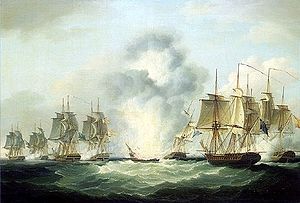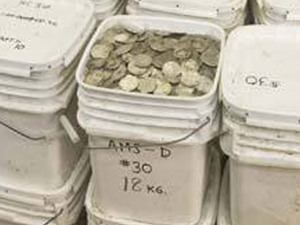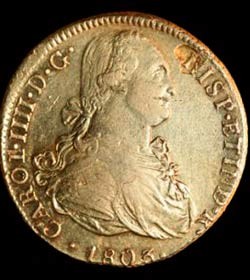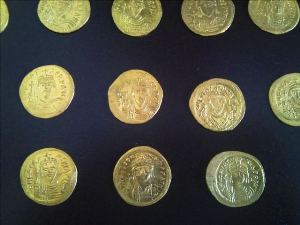Treasure!
01/12/12 04:35

It would have been an evenly balanced fight, were it not for the element of surprise. Both squadrons entered the battle with four frigates. The casualties, however, were very uneven. The British lost 2 and 7 were wounded. The Spanish had 269 killed and 80 wounded. 600 Spanish sailors were captured along with 3 frigates. The fourth frigate, the Nuestra Senora de las Mercedes, was sunk on the 5th of October 1804. The battle set off another round of active fighting between Britain and Spain in what eventually was dubbed the Anglo-Spanish War of 1796-1808.
Spain called the action an act of piracy. They argued that it was an attack in peace time to a Spanish fleet carrying goods and civilian personnel. The Mercedes, however, was at the bottom of the sea and its treasure considered to be lost. The status remained until March of 2007, when Odyssey Marine Exploration recovered 17 tons of gold and silver from the Mercedes. Before the recovered treasure reached the shores of Florida, Spain was in the courts. After more than 200 years of claiming that the Mercedes was a private ship that had been sunk by pirates, the Spanish government changed its tune and claimed in the courts that it was really a sovereign ship, protected by sovereign immunity. The Mercedes, they claimed, had been the property of the Spanish government all along.

Spanish ambassador to the United States, Jorge Dezcallar de Mazar said, “This is history. We bear witness to that fateful day 200 years ago. This is not money. This is historical heritage.”
The argument is a bit difficult to follow. Under international law of the early 1800’s it was in Spain’s advantage to argue that the ship was a private vessel attacked by ruthless pirates and not in any way a factor in the military operations of Spain or its intended continuation of war with Britain. Under the laws of the United States two hundred years later, it was to Spain’s advantage to argue that the Spanish government had owned the ship and its contents all along and that its recovery was in essence theft of Spanish property.
 The first public display of the coins opened in Madrid by the Spanish Culture Ministry. Government officials were quick to point out that the coins were all imprinted with official Spanish Government seals, clearing indicating that the coins belonged to Spain. It was the argument that prevailed in the courts.
The first public display of the coins opened in Madrid by the Spanish Culture Ministry. Government officials were quick to point out that the coins were all imprinted with official Spanish Government seals, clearing indicating that the coins belonged to Spain. It was the argument that prevailed in the courts.It may be convenient to call the coins “history” today. There was a time when they were an important revenue stream for an increasingly costly government that had exceeded the ability of its citizens to pay for its excesses.
No one, I guess, asked or considered how the people of Peru felt in the late 18th and early 19th century about Spanish conquistadors coming to their shores and forcing the indigenous people to work as slaves in mines where the gold and silver were extracted or the mills where the coins were minted, or the shipyards where the coins were loaded into frigates to make the journey to Spain where the Latin American gold was funding a war machine that ultimately proved too expensive for the Spanish to maintain. The requests of the Peruvian government to delay the court decision on ownership while they prepared their arguments for ownership of the treasure were rejected by the courts.
The courts never seriously considered the fact that the way the Spanish got the gold was to steal it.
It seems that there are a lot of people along the way who got greedy when they saw that much gold. The British found ways to spend the gold that they recovered from pirated Spanish vessels. The crews of the British ships found extra pay and earned extra money when they captured valuable cargoes. The Spanish profited richly when the loads of gold and silver reached their intended destinations. It was worth considerable risk in terms of men and equipment to sail from the Americas to Spain with the rich cargo. The Spanish crews were richly rewarded for their efforts if they survived the risks of the open sea.
I have no idea how the courts reached their decision. I have no idea what is right in such a situation. In a way, it seems like Odyssey ought to be able to recover some of the $2.6 million it invested in locating and recovering the treasure. On the other hand oceanic salvage has risks and the risk of losing money is one of those risks. I guess it is a good thing that the Spanish Government has decided that the treasure will be placed in museums. It might be tempting for the cash-strapped government of Spain to sell the treasure in an attempt to balance its books.
 One thing is clear. From the day the gold and silver was mined from the ground, the wealth has not produced lasting happiness for anyone.
One thing is clear. From the day the gold and silver was mined from the ground, the wealth has not produced lasting happiness for anyone. I’m fortunate. I have no claim to any of the treasure. Not one coin, not one portion is mine. And it appears, from what I can read, I am happier than anyone who thinks they should own the gold and silver. Let them fight over it. I’ve found a way to joy without the wealth.